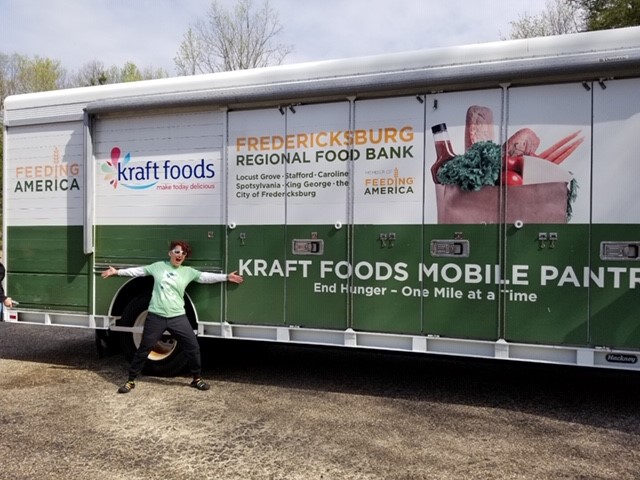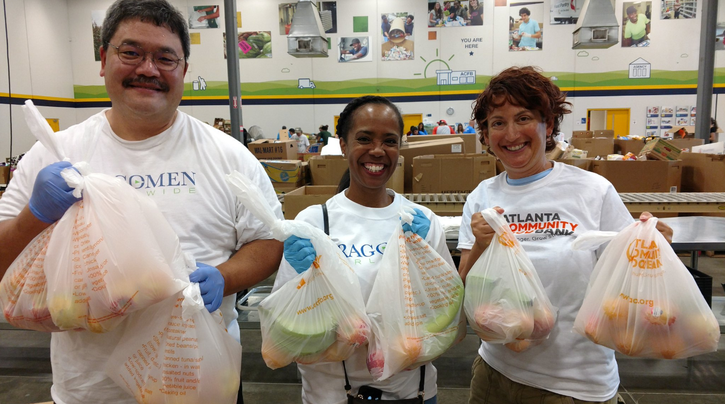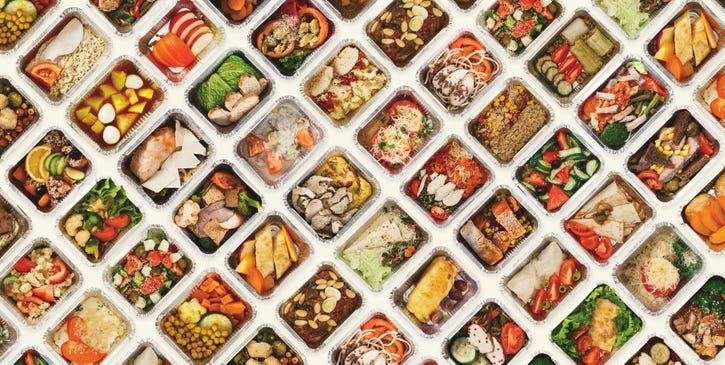Jess Kurti has volunteered at every food bank in Feeding America’s massive network, and she plans to keep going until hunger is eradicated.

When Jess Kurti lost her job during the recession, her whole department became obsolete, and she knew she needed a big change in her life. She just didn’t know what it would look like yet. She took some time off to travel and think. Shortly after she returned, she began volunteering at a Feeding America food bank, motivated to live a more service-driven life.
The more Kurti learned about this huge operation and the face of hunger, the more involved she got. She has since volunteered at every food bank in Feeding America’s massive network, which rescues 3.5 billion pounds of food a year. And her work continues.
Feeding America’s 200 food banks and 60,000 food pantries and meal programs collectively support every county in every state.
“Rescuing food at this scale involves a lot of work. We have to move donations safely and efficiently, which we couldn’t do without our volunteers,” says Liz Baldridge, Feeding America director of sustainability and food waste Initiatives.
Food enters the system from across the supply chain. It comes in different packaging, different forms and different types, which determines how it must be handled.
“In volunteering at every food bank in the network, Jess gained diverse experience in helping divert healthy food from all points of the supply chain, including produce from the farm to grocery store items. She helped ensure this wholesome food reached those in need. And in sharing her unique story and passion for volunteering, she built awareness around food waste and food insecurity and the crucial role volunteers play, which is so meaningful to us as an organization,” says Baldridge.

Waste360: Why did you get involved with Feeding America, and what was your biggest eye-opener once you rolled up your sleeves?
Jess Kurti: After I was laid off, I moved to Orlando, Fla., but the transition was difficult. I decided to embark on a road trip to get a sense of direction and decide what’s next.
When I returned, I knew I wanted to live a service-driven life, which I’d thought of before. But seeing the effects of a downturned economy firsthand further inspired me. I had previously volunteered at my local food bank in Ft. Myers, Fla., and loved it, so I started volunteering at Second Harvest Food Bank of Central Florida. That’s when I learned that both of these operations were part of the Feeding America network and that it included 200 food banks across the country. I was instantly inspired.
I decided I wanted to be the first person to volunteer at every one of these food banks.
As I got more involved, one eye-opener was to learn how much more Feeding America does than the essential job of providing people with food. They’re the top food-rescue organization in the country, rescuing huge volumes that otherwise would have ended up in a landfill. They have partnerships with farmers, industry leads and government organizations to make this happen. I had no idea of this organization’s magnitude and what these individual yet connected food banks accomplish collectively.
Something else that shocked me as I got deeper into volunteering is the number of kids who are hungry, especially college kids. Feeding America is doing a lot of work in this area, getting food banks on campuses to make sure every student is fed to help them achieve their potential.
The face of hunger is so diverse—kids, seniors, veterans, single moms and working families, who often experienced a single setback and can’t make ends meet.
Waste360: How and why did you begin leveraging marathons to raise awareness about food rescue?
Jess Kurti: I combined my love of running with my 200 food bank challenge, seeking to run at least one marathon in each state, eventually upping that goal to 100 marathons. I had become aware of parallels between running marathons and food banking: both require passionate dedication, and both emphasize the importance of healthy food.
I think runners are aware that you can’t perform your best in any area of life unless your body is fed nutritious food. So, I leveraged marathons to increase awareness of hunger and food waste among these passionate athletes. I hoped they would go back to their communities and support the cause there.

Waste360: How does witnessing hunger impact your own food waste reduction habits?
Jess Kurti: I am really careful to buy only what I think I will use. When I’m home, I stick to meal planning, and at restaurants or on the road, I’m conscious to order what will be good for a couple of days if there will be leftovers.
In grocery stores, I buy what doesn’t look perfect. I love straggler bananas that aren’t part of a bunch, even if they’re bruised. We have a mentality in the U.S. that produce has to look a certain way to be edible and healthy, and it couldn’t be further from the truth. This really hits home when I’m at food banks doing quality control, sorting donations from farmers. It may not look pretty, but we make sure it’s not moldy or otherwise unsafe, which is the majority of what comes in.
It’s shameful that 20 billion pounds of good, healthy fruits and vegetables are thrown away every year just because they don’t look a certain way, or it’s a surplus crop and a farmer can’t find someone to buy it. Most is supermarket quality.
Waste360: What especially interesting practices did you see at food banks?
Jess Kurti: One food bank in Wisconsin gets ends of cheeses in bulk. I hadn’t known that cheese doesn’t come out in these perfect, small rectangles you see at the grocery store. So, the food bank has a partnership with cheese producers to get the ends—they’re perfectly good pieces that would otherwise be thrown away. We spent the whole day just breaking apart huge clusters of ends and putting them in vacuum-sealed packages for families. It was a LOT of cheese. And this bank does this frequently.
In New Mexico, Roadrunner Food Bank partners with local supermarket chains. The food bank gives the supermarket bins to collect strawberry tops and almost anything you can think of from cut fruit. When truck drivers do their routes, they also pick up the scraps and bring them back to the food bank. Instead of ending up in the landfill, these fruit pieces go to organizations that raise animals and use them for feed. The day I volunteered there, by morning there were four or five huge bins of scraps ready to pick up.
I love that a lot of these food banks partner with hog farmers. The relationship ended up coming full circle. The animals were fed the scraps provided by the supermarkets. And meat from the animals that were fed goes back to the food bank.
In Florida, we have a big cat rescue—lions, tigers, etc.—that are rescued from illegal owners, retired performers or abusive situations and can’t be released into the wild. The rescue picks up meat donations that humans can’t consume but that are safe for big cats.
Waste360: What are some prevalent system shortcomings and barriers to addressing food waste?
Jess Kurti: We need more education to shift mindsets, maybe beginning in elementary school teaching about what we consume and what we waste. I think it’s important to teach meal planning and how to help people with busy lives not throw out so much.

A while back, I went to a workshop held by a nutritionist about preparing meals from plant-based whole foods. I learned there are so many useable parts of fruits and veggies we toss because we have no idea they can be used. She shared recipes that use carrot tops and the pulp leftover from juicing. She explained we don’t need to peel produce, and that peels are good, nutritious food. As long as you wash fruits and vegetables, there is no reason to throw away the peel.
Besides limited education, another barrier in some areas is establishing relationships with local farmers so food does not end up as waste. A lot of food banks don’t have those partnerships because there are no farmers or compost facilities close by. Or there is not consistent recycling. So much of it ends up in landfills. Feeding America is addressing this with their regional mixing centers that collect huge amounts of fresh produce, package a variety of products and distribute them to local food banks. They have an app, too, that connects stores or truck drivers with nearby food banks, making it simple to donate.
How do we make it more attractive for communities and companies to invest in efforts like recycling or composting? Those are questions that need to be asked to continue progress in reducing waste and eradicating hunger.
Waste360: What has been some out-of-the-box thinking you’ve seen or heard that you think could address food waste and hunger on a national level?
Jess Kurti: I recently read about a hunger-relief program in South Bend, Ind., that was rescuing food from school cafeterias. They froze leftovers and distributed them to kids to have over the weekend. I thought how brilliant would it be to do this nationwide—to freeze seconds and make them into meals? That’s good food that would otherwise have to be picked up by haulers and landfilled.
I think a question is: What policy can be adopted nationwide so more schools can come up with creative models? What monies can we free up to make this happen? While there would be initial cost to create these programs, they could have long-term benefits. Feeding children in this country should be the utmost priority for all of us.

Waste360: Describe the power of grassroots work.
Jess Kurti: That’s where game-changing ideas come from—at the grassroots level. Residents hear of people in their communities who are going hungry, and I think it’s extremely important for them to choose to become invested in their communities.
We need as many voices as possible. At that one school district in Indiana, someone did something small that made a big impact on the local community, but these ideas could end up having far-reaching effects. Someone reads about that local effort and says, “I want to do this where I live.”
Waste360: What’s next for you?
Jess Kurti: I would like to work a staff job in volunteer services and community engagement around hunger relief. My goal is to continue speaking to organizations and other groups about why I have gotten involved in this cause and about how they too can help. And I will continue to run and volunteer at food banks wherever I’m running. I will keep going until we eradicate hunger.
About the Author(s)
You May Also Like




